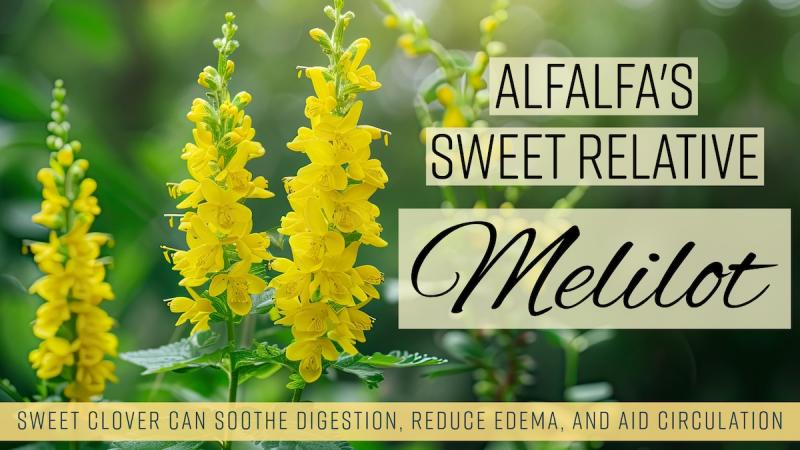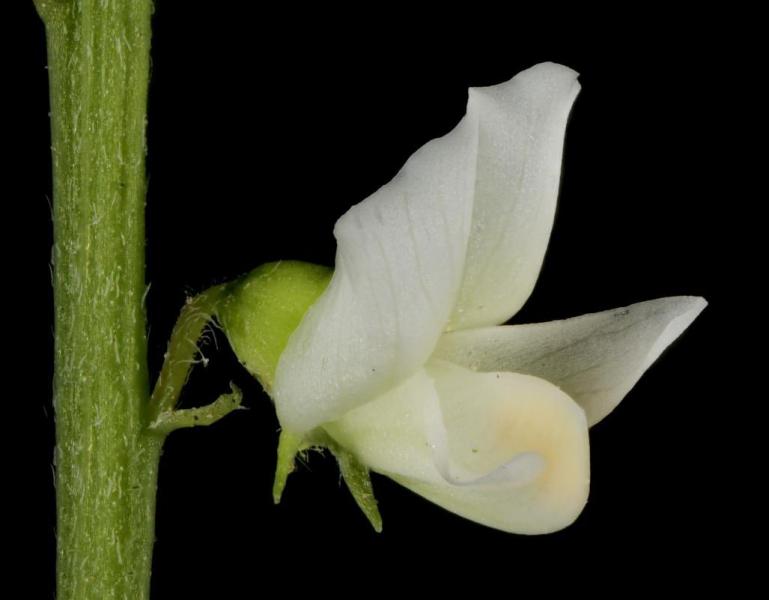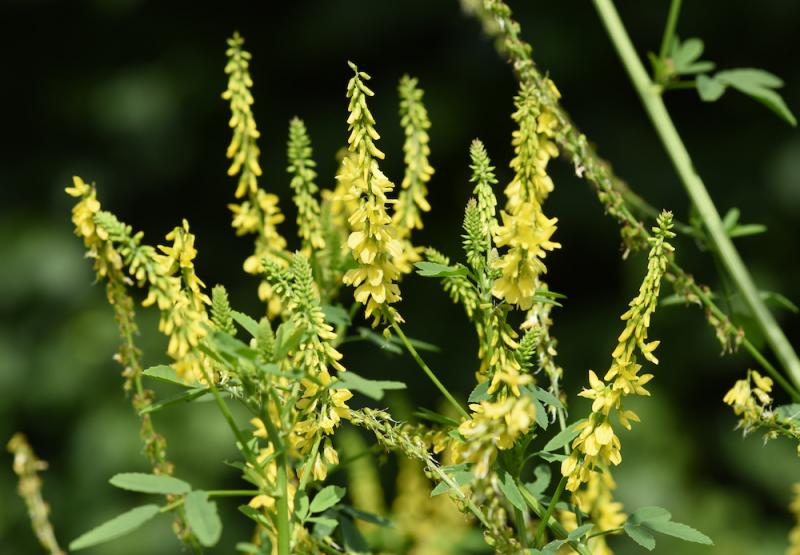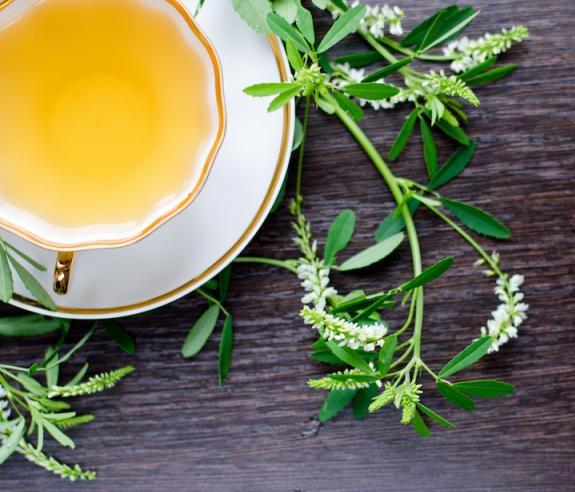
I love to take people on herb walks because I think that the best way to understand herbalism is to get to know the plants. One of the herbs we almost always find is melilot, also known as sweet clover, which grows along roadsides all over Utah. I typically find two kinds, a yellow flowered species (probably Melilotus officinalis or M. indicus) and a white sweet clover (M. alba).
The blossoms and the leaves of melilot are similar to those of alfalfa. They both have similar blossoms and clover-like leaves. Plus, you’ll often find melilot growing near alfalfa fields. It has even been used like alfalfa as an animal feed.
 I’ve known about the medicinal benefits of melilot for a long time, but I haven’t had a lot experience using it. Although, it is in a formula I’ve used for varicose veins and venous circulation because it does have blood-moving effects.
I’ve known about the medicinal benefits of melilot for a long time, but I haven’t had a lot experience using it. Although, it is in a formula I’ve used for varicose veins and venous circulation because it does have blood-moving effects.
Melilot can be crushed and applied topically to bruises and swellings to promote healing. It appears to reduce capillary permeability to stop fluids from leaking into the tissues. It also improves circulation in the legs. The fresh herb has also been used as a tea to soothe and settle the stomach.
At 70, I have some issues with both circulation in my legs and digestion, I’ve decided to experiment with this plant this summer. After all, it’s plentiful and fairly easy to harvest and was once widely used as an herbal medicine. It’s rarely used now, probably out of a misplaced concern over the coumarins it contains.
The Sweet Scent of Coumarins
 The sweet fragrance of melilot is due to the presence of coumarins, which are also found in other sweet-smelling plants such as sweet grass (Hierochloe odorata), sweet woodruff (Galium odoratum) and vanilla grass (Anthoxanthum odoratum). These plants have often been used as a kind of natural air freshener. You can pick them and put them indoors to put a pleasant, sweet, vanilla-like fragrance in the air, which is one of their traditional uses. The dried herb can also be used in pillows like dried lavender.
The sweet fragrance of melilot is due to the presence of coumarins, which are also found in other sweet-smelling plants such as sweet grass (Hierochloe odorata), sweet woodruff (Galium odoratum) and vanilla grass (Anthoxanthum odoratum). These plants have often been used as a kind of natural air freshener. You can pick them and put them indoors to put a pleasant, sweet, vanilla-like fragrance in the air, which is one of their traditional uses. The dried herb can also be used in pillows like dried lavender.
If melilot gets moldy as it dries, the coumarin degrades into dicoumarol. This compound was discovered while investigating bleeding disorders in cattle who had been fed moldy melilot hay. Dicoumarol is an anticoagulant. It inhibits blood clotting by blocking an enzyme involved in the activation of vitamin K1. Dicoumarol became the basis for the anticoagulant drug, warfarin.
Warfarin’s first large-scale commercial use started in 1948 as a rat poison. It was mixed with some type of food that’s attractive to rodents so when they eat it, it prevents their blood from clotting and they start bleeding and lose fluid until they dehydrate and die. Later, in 1954, it was approved as a drug to prevent blood clotting in humans. It is sold under various brand names including Coumadin.
Are Coumarins Anti-Coagulant?
Most of the literature you’ll find on melilot and other plants that contain naturally occurring coumarins suggests they have anti-coagulant activity of their own and therefore should not be taken with anticoagulant drugs. I used to subscribe to the idea that melilot was a natural alternative to anticoagulants, but I’m starting to believe I was mistaken. Melilot appears to improve blood flow and remove stagnation, but I don’t think it acts as an anticoagulant.
Michael Moore, an herbalist from the Southwestern United States, whose books are one of the staples in my library, came to this conclusion. In Medicinal Plants of the Mountain West, he writes “Even though I have warned against excessive use of such a coumarin-containing herb, following accepted semiscientific Conventional Wisdom [CW], I was wrong, and so is the CW.”
 Based on what Michael Moore says and more traditional sources like Maude Grieve’s, Modern Herbal, I think it’s perfectly reasonable to use melilot to improve poor circulation in the legs, swelling, and fluid stagnation caused by chronic inflammation, I don’t think you have to worry about it preventing clotting or over thinning the blood. And since Native Americans and other peoples have eaten both the leaves and the seeds (beans) as food, I don’t think there’s any reason to be concerned about using this plant, other than to make sure it doesn’t mold as it dries.
Based on what Michael Moore says and more traditional sources like Maude Grieve’s, Modern Herbal, I think it’s perfectly reasonable to use melilot to improve poor circulation in the legs, swelling, and fluid stagnation caused by chronic inflammation, I don’t think you have to worry about it preventing clotting or over thinning the blood. And since Native Americans and other peoples have eaten both the leaves and the seeds (beans) as food, I don’t think there’s any reason to be concerned about using this plant, other than to make sure it doesn’t mold as it dries.
So, here’s what I plan to do this summer. I’m going to gather some leaves and flowers of melilot and dry them in my food dehydrator, so they have plenty of air circulation and no risk of mold. Then, I’m going to make tea from them and see how it affects my digestion and peripheral circulation. I may also try making both a fresh plant tincture and fresh plant glycerite and trying them both. Hopefully, I'll have interesting results to report back in the fall. Considering how plentiful melilot is, and how easy it is to harvest, it might be worth bringing this herb back into more mainstream use.
Steven's Articles
-

-
The Health Benefits and Problems with Coffee
This popular caffeinated beverage can be beneficial…
October
-

-
Understanding Caffeine & Cellular Adaptation
Preserving the power of caffeine's buzz and the…
September
-

-
Horseradish
A pungent spice for aiding protein metabolism…
-

-
Banaba or Crepe Myrtle
A beautiful tree from Southeast Asia whose leaves…
August
-

-
Monkeyflowers
Flower essences to help see ourselves more clearly…
-

-
Mariposa Lilies
Strengthening the bond between mother and child…
-

-
The Noble Bay Leaf
A common kitchen herb for aiding digestion and…
-

-
Epimedium: Horny Goat Weed
A circulatory stimulant and kidney yang tonic…
July
-

-
The Medicinal and Nutritional Benefits of Apricots
A nutritious fruit and valuable medicinal seed for coughs
-

-
Dogwoods
Asian dogwood is used to stop excessive discharge,…
June
-

-
Neem: The Village Pharmacy
A popular Ayurvedic remedy for dental and immune…
-

-
Spilanthes: The Toothache Plant
A traditional remedy for teeth and gums, as well…
-

-
Forsythia
An anti-inflammatory, fever-reducing, and infection fighting herb
May
-

-
Buckwheat (Kashi)
A delicious, high protein, gluten-free, gut-healthy food
-

-
Leaky Gut Syndrome
Plugging the leaks on the underlying cause of…

